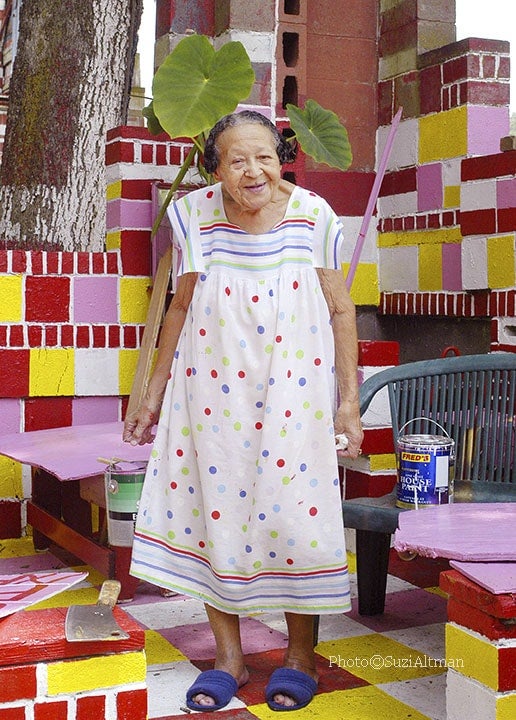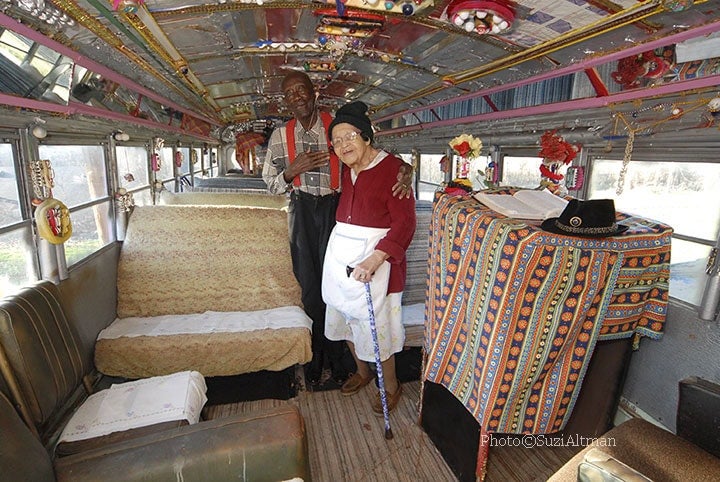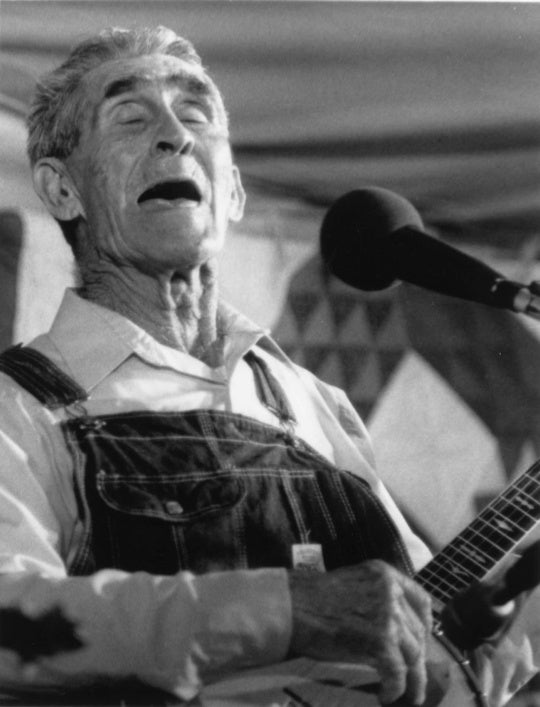
It all started with a promise.
“He asked me would I marry him,” Margaret Rogers Dennis recounted years later of Reverend Herman Dan Dennis’s proposal to her in 1984. “I wasn’t exactly sure. But he said, ‘If you’ll marry me, I’ll turn your little old brown plank store into a palace.’” The reverend kept his promise. He turned the old run-of-the-mill grocery store that Margaret ran with her first husband, who was tragically killed in a robbery at the store, into a colorful mecca where “ALL IS WELCOME JEWS AND GENTILES.” Multiple towers made of cinder blocks painted red, blue, pink, and yellow decorate the property, and the main building itself — the grocery — is similarly painted in multicolored squares and rectangles. Many liken the overall effect of these geometric blocks of color to a religious “Lego fortress,” but it is also reminiscent of Mondrian’s distinctive color blocking—had he ever projected his patterns over an entire property rather than a single canvas, that is. Margaret and Rev. H. D. Dennis ran Margaret’s Grocery, just north of Vicksburg, Mississippi, off of old Highway 61, as both a grocery store and a religious center, and Dennis kept operating the site after his wife’s death in 2009. He himself passed away in 2012. In far too many cases, the death of an artist like Dennis, whose creation is a full “environment,” means the end of the art environment, too. Fortunately for Rev. H. D. Dennis — and of course, Margaret, too — another promise was made.
In 2000, celebrated photographer Suzi Altman moved from New York to Mississippi, and while volunteering on a movie set near Vicksburg, she heard other crew members talking about a remarkable site nearby that they insisted she needed to visit and photograph. Altman took their advice, and upon arriving, she was immediately captivated by what she saw at 4535 North Washington Street. Soon after she parked, the Rev. H. D. Dennis emerged. He was wearing seersucker pants and gold Mardi Gras beads, and she noticed that his eyes appeared blue. He had what looked like a transistor radio earpiece in his ear, and she observed a red liquid splattered at the bottom of his pants. “Being the fresh Yankee that I was,” Altman reflects, “I thought maybe it was blood.” “Is he killing his dinner in the backyard?” she wondered. No, thankfully, it was just red paint, and Dennis went on to deliver one of his signature sermons to Altman about equality before a non-discriminatory God. What “Preacher,” as Altman and most others who knew him in the Kings community call Dennis, preached resonated with Altman, and she “immediately fell in love with them,” as she says. Indeed, Miss Margaret was there that day sitting on the porch with her long braids wrapped into buns on the top of her head. “She was lovely,” Altman remembers.

It turned out that Dennis’s eyes appeared blue due to cataracts, and that transistor radio earpiece was a hearing aid: the reverend was practically blind and deaf. In other ways, too, his health was declining, and on Miss Margaret’s deathbed, she begged Altman to take care of Dennis after she passed. Altman loyally agreed, and the second promise had been made. Altman spoke at Margaret’s funeral, and an anonymous donor paid her medical bills, funeral costs, and made sure she got the “Rolls Royce of caskets,” with details inside and out in Margaret’s favorite color, pink. The same donor took care of Dennis’s arrangements as well. “They had a lot of people who thought the world of them,” Altman reflects. It was by Dennis’s deathbed where the third, and perhaps most lasting, promise was made. “Suzi, promise me!” Dennis implored. “Promise me you’ll take care of my palace!” Altman agreed once again, and she later spoke at Dennis’s funeral, too.
In 2013, a year after Dennis passed away, Altman established the Mississippi Folk Art Foundation and began her work trying to save the grocery from the elements and vandals alike. “We’re a one-man band,” Altman jokes about her work at Margaret’s Grocery over the last six years. “I’ve repaired the roof, and I maintain the grass and repair brickwork,” she proudly recounts. In 2017, she and her wife, Nancy Anne Branton, attended the Road Less Traveled conference in Sheboygan, Wisconsin, where they were surprised to discover a whole community of folks who care for similar art environments. “Everyone was lovely!” she remembers. This introduction to the world of art environment preservation helped reinforce for Altman her determination to save Margaret’s Grocery. Recently, when members of the Wisconsin-based Kohler Foundation Inc., an organization known for its preservation work at art environments across the country, visited the grocery, they were intrigued by what Altman had accomplished. “Suzi, how did you know to do that?” she says they would ask, and she laughs. “There’s this amazing thing called the internet, and you can ask Siri or Google all kinds of things!” Altman has also consulted with Dr. Jassen Callender of Mississippi State University, who has advised her on structural repairs and whom Altman calls “an amazing resource.” “I may not have a degree in preservation from a fancy college,” she observes, “but you can get a lot of what you need from Home Depot.”
Though Altman wasn’t aware of it at the time, Rev. H. D. Dennis’s work was featured in the two-volume anthology of African American vernacular art released by the Souls Grown Deep Foundation, based in Atlanta, Georgia, in 2000 and 2001. In it, Souls Grown Deep founder William S. Arnett describes his interviews with Dennis in the late 90s and importantly connects his work with well-established art from the canon, including Mondrian, as was noted at the beginning of this essay. “You won’t find this nowhere else in the world because God gave me the vision to do it just like this,” Dennis reported to Arnett. “It’s amazing,” Altman reflects on the anthology today. “One chapter is about Preacher, and the next is Thornton Dial.” Dial, of course, is one of the most well-known and critically acclaimed artists featured in Arnett’s comprehensive anthology. It’s in such company that Dennis, whose palace stands as a testament to true love, love of God, and love of all creation, belongs.
Like Dial, whose self-taught art drew heavily from his experience in brickwork, cement work, metalwork, and carpentry, Dennis, too, never trained as an artist in a formal capacity. “I learned everything I know in Columbus,” Dennis told Arnett when he discovered that was the art collector’s birthplace. In fact, Dennis was ordained at St. Peter Missionary Baptist Church in Columbus, Georgia, in 1936, and he later joined the army at nearby Fort Benning. After serving in the military during WWII, Dennis returned to Columbus. As Arnett notes, through the G.I. bill, the Veteran’s Administration offered Dennis “four years of trade schooling in the art of brick masonry, a skill he first learned from German prisoners.” They showed Dennis “how to do stuff hadn’t nobody else done in this world, do it different, and you can always tell it’s your own work,” as he told Arnett. He later spent twenty-three years in Detroit as an autoworker building Chryslers, and it was those experiences and the skills learned from them that informed Dennis’s unique artistic approach.

One of the best representations of Dennis’s approach, and one of the highlights of Margaret’s Grocery during its heyday, is the bus. “It’s a bus on the outside and God’s place in the inside,” Dennis told Arnett. The interior of the bus, “God’s place,” can be defined as a “careful organizing of chaos,” to use Arnett’s phrase, decorated as it is with “beads, found material, artificial flowers, hubcaps, aluminum pie plates, light bulbs, lots of gold and silver and red and blue paint, some biblical art reproductions, and much more.” Like many other self-taught artists, Dennis gives seemingly every inch of space the same amount of attention and care, creating an “all-over” effect not unlike the work of some mainstream Abstract Expressionists. The result is a beautiful mosaic of flashy colors, with every detail contributing to the bus’s almost disco-like atmosphere. To protect this artistic wonder from the relentless sun there in the Mississippi Delta, Altman has relocated the bus and covered it in tarp.
Like the rest of the property, including the large installations in front of the grocery, the bus reflects Dennis’s theory about diversity: “It’s a bouquet. We is all a bouquet for God. Everything God made — trees, automobiles, flowers, everything that lives — is different colors of God’s bouquet. We make a beautiful bouquet of colors with our different shades of skin.” For Dennis, diversity, difference, and variety are keys to achieving beauty, and his artwork is not only a promise kept to a lover, but also a gesture towards divine inspiration. As one of his religiously inspired signs reads, JEWS AND GENTILES ONE IN CHRIST JESUS ALL IS WELCOME DENOMINATION IS NOT THE CHURCH. For Dennis, the differences that separate us so often in the everyday, material world may actually help to unite us in the spiritual world. GOD AIN’T GOT NO BLACK CHURCH HE AIN’T GOT NO WHITE CHURCH HE HAS ONE CHURCH WHERE ALL ARE WELCOME, signs on the property read, and Dennis often related this same message to visitors.

Back home in Jackson, Mississippi, about seventy miles from Margaret’s Grocery, Altman received an email from Scott Browning, Director of Collections at the Souls Grown Deep Foundation, on December 9, 2018. He had come across Altman’s story in the fall 2018/winter 2019 issue of the Folk Art Messenger, and he wanted to meet her. Browning writes, “As we have a page on our website dedicated to Rev. Dennis, and Margaret’s Grocery is on The Mississippi Heritage Trust’s list of 10 most endangered properties, we were eager to learn of the current state of Margaret’s Grocery—from the structural integrity of the building and church bus to discreet objects such as the Ark of the Covenant.” In their first meeting, Browning explained to Altman that the groundbreaking foundation had a little money left at the end of their fiscal year, and they wanted to help her keep her promise to Dennis. “The preservation of an art environment such as this is an enormous endeavor—one that [Altman] has undertaken with scarce resources, but with deep commitment and a keen understanding of the site’s meaning and significance,” says Browning. “As SGDF recently became. a granting organization, we were eager to explore ways in which we could support her efforts.” The result: a $10,000 grant, the first of its kind the Souls Grown Deep Foundation has issued, to the Mississippi Folk Art Foundation for the purpose of saving Margaret’s Grocery.
“I was stunned,” Altman remembers. “To me, it’s like a million dollars!” With this extraordinary gift, Altman hopes to begin checking items off her long to-do list: creating a website for Margaret’s Grocery, designing a new brochure for marketing purposes, hiring a few helpers to repaint portions of the towers and signs, installing scaffolding, paying for D & O insurance, and continuing to rent temperature-controlled pods for the artwork. She has also already consulted with Parma Conservation, an organization based in Chicago that specializes in paint restoration and recently worked with the Kohler Foundation on the restoration of the art environment known as Pasaquan, just outside of Buena Vista, Georgia. Additionally, she hopes to continue her community project to teach local youth to use their phones as instruments of preservation rather than just “toys,” in an oral history project she’s working on in the Kings community. As they tell it, the children from Cool Spring Church, located directly behind Margaret’s Grocery, frequently visited Preacher during the time they were supposed to be attending youth events. They came to Dennis before returning to the church in advance of the sermon’s ending. In addition to delivering his sermons about love, he gave them candy, they say. Indeed, Dennis was a local treasure.
“There is not another one like me,” Dennis once told Arnett. And he was right. Though it’s true that each self-taught art environment is inherently unique, Rev. H. D. Dennis and Margaret’s Grocery reminds us that art environments can balance the abstract with the figurative, and also high with low art. He probably never could have imagined it in his lifetime, but Dennis is at the crux of a conversation that’s happening right now in the art world about the value of art coming from unexpected places, and who decides whether someone like Dennis is or isn’t a significant cultural producer. Who’s an outsider, in other words, and what does it mean to be on the inside? Artists like Dennis, who are often forgotten, and whose creations are often condemned or demolished, are now being elevated in esteem by the generous donation from the Souls Grown Deep Foundation and the determination of Suzi Altman and her friends. And that’s something in itself to celebrate.
“I’m committed to preserving Margaret’s Grocery,” Altman says with resolve. The Rev. H. D. Dennis kept his promise to Margaret, and it seems now that Altman is doing everything she can to keep her promise to Dennis. Thanks to the Souls Grown Deep Foundation, she can continue her work to save his palace.
You can contribute to the efforts of the Mississippi Folk Art Foundation to save Margaret’s Grocery by donating to its GoFundMe campaign and see more images on Suzi Altman’s website.




